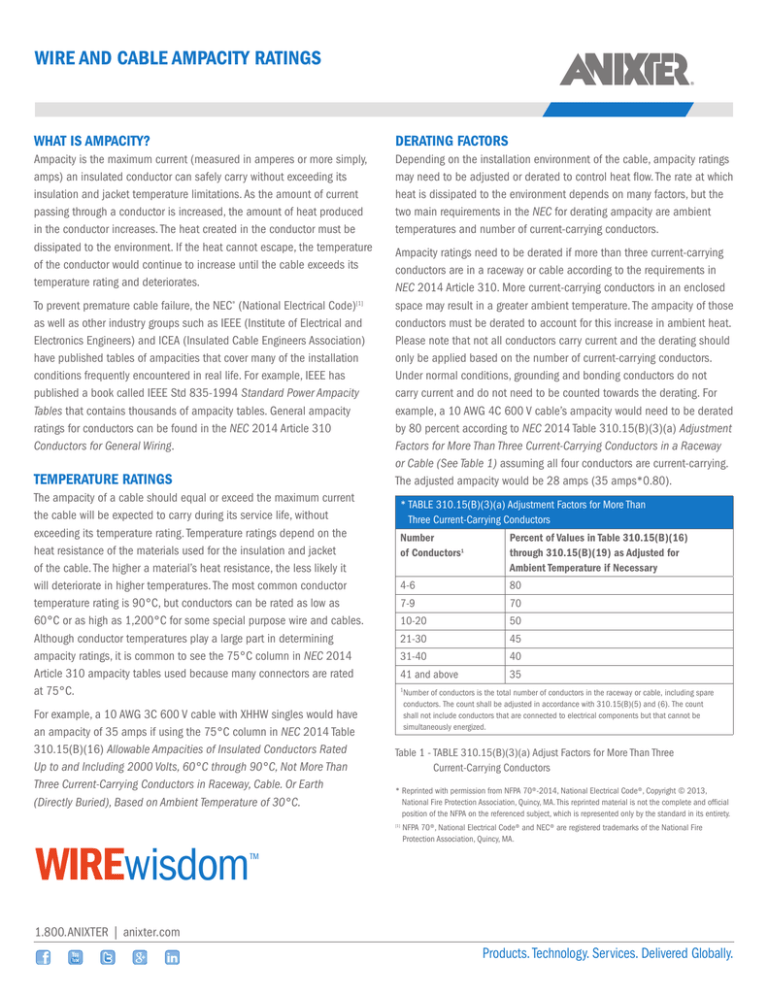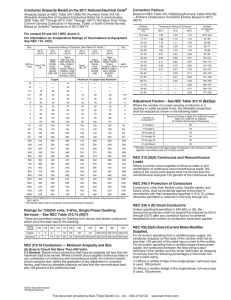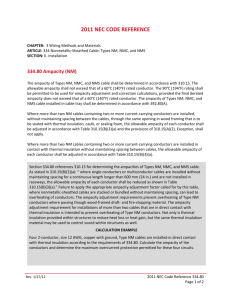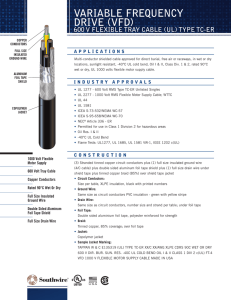WHAT IS AMPACITY?
advertisement

WIRE AND CABLE AMPACITY RATINGS WHAT IS AMPACITY? DERATING FACTORS Ampacity is the maximum current (measured in amperes or more simply, amps) an insulated conductor can safely carry without exceeding its insulation and jacket temperature limitations. As the amount of current passing through a conductor is increased, the amount of heat produced in the conductor increases. The heat created in the conductor must be dissipated to the environment. If the heat cannot escape, the temperature of the conductor would continue to increase until the cable exceeds its temperature rating and deteriorates. Depending on the installation environment of the cable, ampacity ratings may need to be adjusted or derated to control heat flow. The rate at which heat is dissipated to the environment depends on many factors, but the two main requirements in the NEC for derating ampacity are ambient temperatures and number of current-carrying conductors. To prevent premature cable failure, the NEC® (National Electrical Code)[1] as well as other industry groups such as IEEE (Institute of Electrical and Electronics Engineers) and ICEA (Insulated Cable Engineers Association) have published tables of ampacities that cover many of the installation conditions frequently encountered in real life. For example, IEEE has published a book called IEEE Std 835-1994 Standard Power Ampacity Tables that contains thousands of ampacity tables. General ampacity ratings for conductors can be found in the NEC 2014 Article 310 Conductors for General Wiring. TEMPERATURE RATINGS Ampacity ratings need to be derated if more than three current-carrying conductors are in a raceway or cable according to the requirements in NEC 2014 Article 310. More current-carrying conductors in an enclosed space may result in a greater ambient temperature. The ampacity of those conductors must be derated to account for this increase in ambient heat. Please note that not all conductors carry current and the derating should only be applied based on the number of current-carrying conductors. Under normal conditions, grounding and bonding conductors do not carry current and do not need to be counted towards the derating. For example, a 10 AWG 4C 600 V cable’s ampacity would need to be derated by 80 percent according to NEC 2014 Table 310.15(B)(3)(a) Adjustment Factors for More Than Three Current-Carrying Conductors in a Raceway or Cable (See Table 1) assuming all four conductors are current-carrying. The adjusted ampacity would be 28 amps (35 amps*0.80). The ampacity of a cable should equal or exceed the maximum current the cable will be expected to carry during its service life, without exceeding its temperature rating. Temperature ratings depend on the heat resistance of the materials used for the insulation and jacket of the cable. The higher a material’s heat resistance, the less likely it will deteriorate in higher temperatures. The most common conductor temperature rating is 90°C, but conductors can be rated as low as 60°C or as high as 1,200°C for some special purpose wire and cables. Although conductor temperatures play a large part in determining ampacity ratings, it is common to see the 75°C column in NEC 2014 Article 310 ampacity tables used because many connectors are rated at 75°C. For example, a 10 AWG 3C 600 V cable with XHHW singles would have an ampacity of 35 amps if using the 75°C column in NEC 2014 Table 310.15(B)(16) Allowable Ampacities of Insulated Conductors Rated Up to and Including 2000 Volts, 60°C through 90°C, Not More Than Three Current-Carrying Conductors in Raceway, Cable. Or Earth (Directly Buried), Based on Ambient Temperature of 30°C. *TABLE 310.15(B)(3)(a) Adjustment Factors for More Than Three Current-Carrying Conductors Percent of Values in Table 310.15(B)(16) through 310.15(B)(19) as Adjusted for Ambient Temperature if Necessary 4-6 80 7-9 70 10-20 50 21-30 45 31-40 40 41 and above 35 1 Number of conductors is the total number of conductors in the raceway or cable, including spare conductors. The count shall be adjusted in accordance with 310.15(B)(5) and (6). The count shall not include conductors that are connected to electrical components but that cannot be simultaneously energized. Table 1 - TABLE 310.15(B)(3)(a) Adjust Factors for More Than Three Current-Carrying Conductors * Reprinted with permission from NFPA 70®-2014, National Electrical Code®, Copyright © 2013, National Fire Protection Association, Quincy, MA. This reprinted material is not the complete and official position of the NFPA on the referenced subject, which is represented only by the standard in its entirety. [1] WIREwisdom Number of Conductors1 FPA 70®, National Electrical Code® and NEC® are registered trademarks of the National Fire N Protection Association, Quincy, MA. TM 1.800.ANIXTER | anixter.com Products. Technology. Services. Delivered Globally. WIRE AND CABLE AMPACITY RATINGS If multiple single conductors or multiconductors (rated 0–2,000 V) are installed without proper spacing, derating may be required. For more information, please refer to NEC 2014 Section 310.15 Ampacities for Conductors Rated 0-2000 Volts. FAQ 1. Why do flexible cords or portable power cables have higher ampacity ratings compared to NEC 2014 Section 310 Conductors for General Wiring? The ambient temperature is vital when determining ampacity ratings because at higher temperatures heat transfers out of the cable at a slower rate. If the ambient temperature differs from the ampacity tables’ stated ambient temperatures (typically 30°C or 40°C) in NEC 2014 Article 310, a correction factor may need to be applied. NEC 2014 Table 310.15(B)(2)(A) Ambient Temperature Correction Factors Based on 30°C (86°F) is one of the tables where adjustment factors can be found. For example, a 10 AWG 3C 600 V cable is installed in an ambient temperature of 50°C. According to NEC 2014 310.15(B)(2)(A), the cable’s ampacity would need to be multiplied by a correction factor of 0.75, assuming the 75°C column was used in the ampacity table. The adjusted ampacity would be 26 amps. INDUSTRY EXAMPLE Temperature ratings and ambient temperatures play a big role in solar farms’ ampacity ratings. Photovoltaic wire (PV wire) is used as interconnection wiring on solar panels in grounded or ungrounded systems. PV systems, including PV modules, PV source circuits and PV output circuits, can produce output currents that are higher than the rated short-circuit currents for over three hours. Due to the large amount of current and warm temperatures, PV wire’s ampacity is calculated as 125 percent of the sum parallel module rated short-circuit currents. There are many factors that affect the appropriate conductor and cable selection, and incorrect product selection can be costly. Flexible cords and portable power cables are not permitted by NEC 2014 Section 400.8 to be installed in raceways, concealed by walls or floors, or installed in dropped ceilings. These cable types are assumed to be installed in applications where there is adequate space and free air. Because of these anticipated installation conditions, overheating from being enclosed in a small space is not a large concern. Therefore, these cables are permitted to carry more current per gauge size compared to cable and wire types mentioned in NEC 2014 Section 310 Conductors for General Wiring, which typically are installed in applications with limited air space or air movement. Ampacity tables for flexible cords and cables can be found in NEC 2014 Section 400.5 Ampacities for Flexible Cords and Cables. 2. What are the ampacity requirements for conductors used in continuous duty applications for single motors? According to NEC 2014 Section 430.22 Single Motor, conductors shall not be rated less than 125 percent of the motor full-load current. For example, if the FLC of a motor is 120 amps, the ampacity rating would be 150 amps (120*1.25) at the minimum. 3. I need higher ampacity and want to save money and weight by using a welding cable because they have higher ampacity ratings. Which welding cable do I select? Welding cable ampacity ratings depend on many factors including the length of the welding circuit, rated output of the welding power source, and the duty cycle of the welding source. Unless the variables are known and can be accounted for, it is not recommended to use welding cables in nonwelding applications. For more information about the technical requirements to make the proper cable selection, please contact an Anixter sales representative at 1.800.ANIXTER for more assistance. About Anixter: anixter.com/aboutus Legal Statement: anixter.com/legalstatement 14F3099X00 © 2014 Anixter Inc. • 03/14 Anixter Inc. World Headquarters 2301 Patriot Boulevard Glenview, Illinois 60026 224.521.8000 WIREwisdom TM 1.800.ANIXTER | anixter.com Products. Technology. Services. Delivered Globally.



